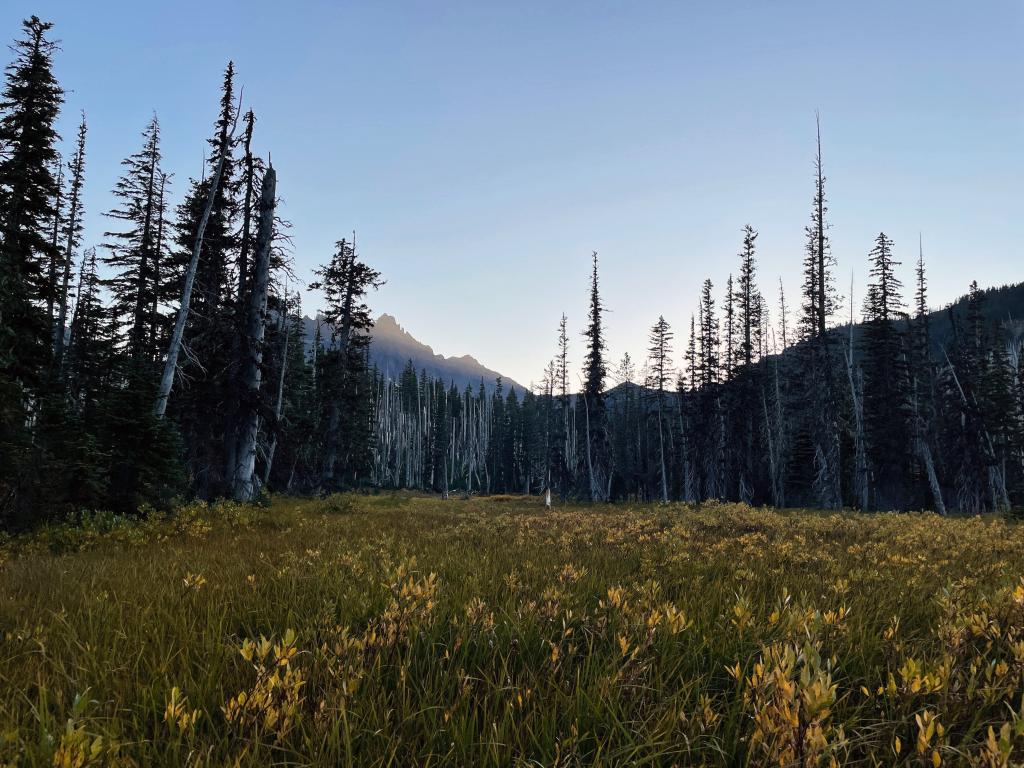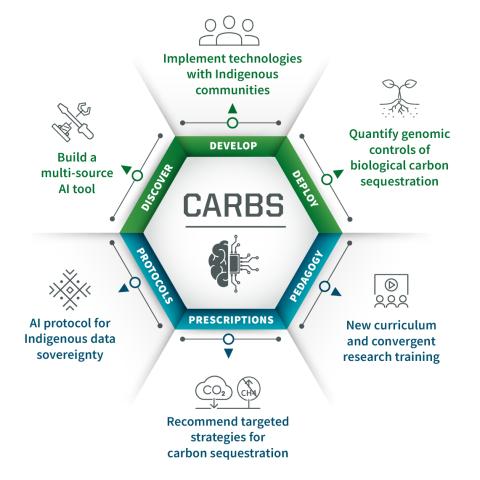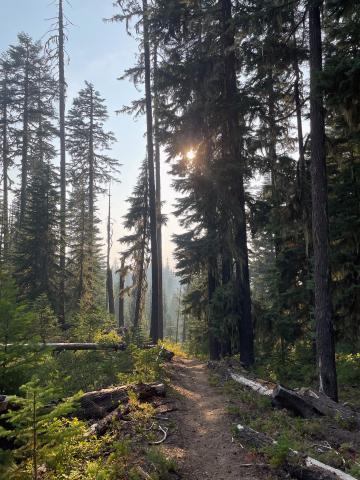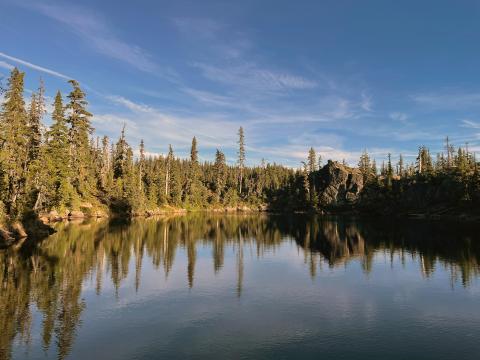
The issue of climate change is so large it’s easy to feel powerless. How can any one person, community, or institution tackle a problem global in scale, in which the unintended consequences of choices made on one side of the globe affects people on the other?
The short answer is, they can’t. But by mitigating the effects of a changing climate in a local area, groups of people can have an impact and provide an example for other communities to do the same. The enormous problem of climate change is also an opportunity to rise to the challenge and build connections and trust at the same time.
That’s the goal of the Convergence to Accelerate Research on Biological Sequestration (CARBS) project undertaken by the University of Oregon and the Kō-Kwel/Coquille Indian Tribe.
Using a combination of environmental samples, Traditional Indigenous Knowledge, remotely sensed observations, and AI, the research partners aim to develop a land management plan for a million acres spread over five Oregon counties that will sequester carbon more effectively. The work is funded by a five-year, $3 million National Science Foundation grant.

If the project seems ambitious, that’s because it is. The scope, like the million acres of the land management area, is large. But at its heart, CARBS is a grassroots approach and one the research team hopes will provide an example for others to implement in their own communities.
“Top-down decision-making about increasing carbon sequestration is an old-school engineering approach that ultimately displaces people and expects certain countries to remain frozen in time while others are allowed to advance. That can’t happen,” said Lucas Silva, a professor of environmental studies and biology in the UO's College of Arts and Sciences, Philip H. Knight Chair of Natural Sciences, and a leader on the CARBS project.
“Instead, we are approaching this from the theory of collective action: People organize at community scale and come together. Everyone has skin in this game. The case of wildfires in the American West is a good example: It brings people together—farmers, ranchers, foresters, Indigenous folks—in otherwise unlikely alliances that catalyze local action.”
Other impacts of the changing climate have become increasingly noticeable, such as plummeting salmon populations and drier summers that contribute to mass conifer tree die-offs. And while anecdotal evidence can be compelling, establishing a base line of environmental conditions is critical to any land management decision-making and requires a team approach.
“You put more people in the canoe, the canoe goes a little bit faster,” said Jason Younker, chief of the Kō-Kwel/Coquille Indian Tribe and the assistant vice president and advisor to the president on sovereignty and government-to government relations at the University of Oregon. “Carbon sequestration is something that we likely wouldn’t have addressed 20, 30, 40 years ago. This project highlights the mistakes of our past, but also give us a direction to move forward. It provides clear scientific evidence that there are changes impacting humans, not just the wildlife. Ask the fisherman how many salmon are out there to catch. Ask the crabbers. That’s the power of scientific data: it shows us the way back to normal. And in this case, by using traditional ecological knowledge.”
A Multi-pronged Approach

The NSF grant calls for using “the rules of life,” to address societal change, which purposefully brings together researchers from different academic disciplines. The UO project will use rules, patterns, and processes that can be generalized across ecosystem gradients to answer big questions: How do local-scale land-use management decisions contribute to an area’s carbon budget? Can certain areas on landscapes be prioritized for their ability to sequester carbon? And if so, using a swath of land that stretches from estuary to forest in Oregon as laboratory, are lessons learned here broadly applicable across the globe?
“It’s hard to be an ecologist now and not have a strong sense of how climate change is impacting ecosystems. I want it to be part of the response,” said Lillian Aoki, assistant professor of environmental studies. “This is not a restoration project per se, but in restoration ecology, we talk about ‘cathedral thinking’: We’re laying the foundation, but the full cathedral won’t be built in our lifetimes. Every experiment I do isn’t going to be the one that saves the world from climate change, but I’m motivated to lay that cathedral foundation.”
Biologist Silva focuses on forest ecosystems, and how different management practices, such as prescribed burning and sustainable logging, affect the landscape. Aoki studies ecosystem processes in estuaries, specifically those that have been diked or drained and those that have been reconnected to hydrological systems. Aoki and Silva hope to connect the dots on how degraded ecosystems from Coos Bay up the Coquille River into the heavy timber of the Coastal and Cascades mountain ranges may sequester carbon at different rates from restored lands.
“There’s a lot of heterogeneity within these landscapes and ecosystem processes—and in the people there, in their interactions and relationships with the landscape,” Aoki said. “How do we measure the processes to understand the relationships? We recognize that it’s not about a top-down dictate that every landscape should be managed in this way. Rather, we want to think local and act local about the interconnectivity of systems, of science, of relationships.”
It takes variety of environmental measurements to determine an ecosystem’s metabolism—where carbon comes in or out. The research team will combine high-resolution satellite imagery of land surfaces in collaboration with Qing Zhu, an Earth system scientist and modeling expert at the Lawrence Berkeley National Lab. They’ll collect methane and carbon dioxide readings from Eddy Covariance Flux Towers, a distributed network of towers that take meteorological measurements at a certain height above photosynthesizing vegetation and respiring plant and animal populations. These measurements will be ground-truthed using small plastic chambers placed over patches of marshes or forest soil to look at small-scale gas fluxes as soil moisture and temperate change. The researchers will study the differences in microbial communities in terrestrial and estuarial soils.
Brendan Bohannan, professor of biology and the James F. and Shirley K. Rippey Chair in Liberal Arts and Sciences, will extract and analyze DNA from the environmental samples to better understand how microorganisms influence carbon metabolism at test sites. Often called “eDNA,” the samples are essentially a census of thousands of soil microbes, both past and present. The microbial head count helps researchers determine which soils are most attractive to the microbes that consume specific metabolites or respire at certain rates, for example. These tiny denizens of the dirt may also hold clues to how land management practices like prescribed burns change carbon inputs in the immediate vicinity and downstream. The microbiome is a connection point between the otherwise very different forest and estuary ecosystems.
“CARBS will address climate change from a variety of perspectives, but I feel that the most transformative aspect of the project is the integration of Indigenous knowledge with other forms of information, to create an approach to carbon capture that is effective because it is grounded in local knowledge,” Bohannan said.
From this wide variety of observations, Jake Searcy, assistant research professor of data science, will develop machine-learning models to predict natural carbon sequestration. These models help comb through large sets of existing data to help identify patterns related to carbon drawdown. The models could suggest which actions may have the greatest impact, whether its which marsh can serve as a carbon sink while acting a filtration system for pollutants, or a carbon dioxide-metabolizing microbe that could be inoculated into soils at certain locations.
“I'm always looking for places where algorithms and computational methods can make positive impacts on society, which is exactly what CARBS will allow us to do,” Searcy said. “We'll use those models to help better understand the impacts of the microbiome, so our land management partners have all the information they need from the soil up to help fight climate change.”
Centering Indigenous Knowledge
Advances in remote sensing tech and AI trained to parse terabytes of data make such a grand project possible. But all the tech in the world can’t build lasting human relationships. And so that is an equally important aspect of the CARBS project: Forging connections founded in trust and shared priorities.

“A phrase being used widely among Indigenous peoples is, ‘Nothing about us without us,’” said Ashley Cordes, assistant professor of Indigenous Studies in Environmental Studies and English at the UO and a citizen of the Kō-Kwel/Coquille Nation. “This means that while historically Indigenous peoples have been excluded from or harmed by policy decisions and research coming out of universities, we are ensuring that we not only have a say in decisions but are respectfully in control of them as sovereign nations.”
Cordes conducts research at the nexus of relationships between Indigenous communities, land-based and virtual places, and digital media. She notes that it’s critical for the project to have the Kō-Kwel/Coquille Nation engaged and to feel ownership about the data that emerges from it. Part of the work Cordes is doing for the CARBS project is to create protocols for the ethical use of eDNA to ensure data sovereignty for the community.
“Our Nation is strict on the types or research that we allow, and this project takes seriously the process of meaningful engagement, reciprocity, culturally appropriate processes, ethical protocols, and prioritizing care for the Nation,” she said.
Cordes said that the CARBS project builds on current engagement with the Kō-Kwel/Coquille Indian Tribal Council and the Tribal Resiliency Taskforce, including listening to Elders and other Tribal citizens’ concerns about the impacts of climate change on youth and generations to come. Recently the Oregon Department of Fish and Wildlife Commission unanimously approved the Kō-Kwel/Coquille Nation’s historic bid for a co-management agreement that affords the sharing of responsibility for managing fish and wildlife in Coos, Curry, Douglas, and Lane counties. This came after the Nation engaged in efforts to help in the prevention of the extinction of the Fall Chinook Salmon.
“As the Nation builds capacity to care for the lands and waters, it becomes important to form relationships, engage in reciprocal research efforts, and honor Indigenous ways of treating the more-than-human world,” Cordes said.
Opportunities for Mentorship and Leadership

Capacity building in the next generations of scientists and citizens alike is another facet of the grant. Through curriculum development including best practices on ethical engagement with Indigenous communities, convergent research training with students and tribal members, and mentorship, CARBS provides opportunities to students and researchers alike to grow. Martin Storksdieck, director the STEM Research Center at Oregon State University will provide an external evaluation of project’s impact to inform future work.
For Jason Younker, the CARBS project is a chance to mentor up-and-coming Indigenous scholars.
“Individuals like me within the Tribe are always trying to find the next person to fill our shoes. If you’re not working toward that, you’re not doing your job,” he said. “Knowing that Ashley, a Tribal citizen, and Lillian, an ally, are coming behind me is a comfort. She represents the next generation of Tribal and ally scholars and the dividends of the investment Tribes have made investing in the next generation of scholars. Not only for self-preservation, but to change the public’s view of the resources we have known our entire lifetimes and for millennia, that we are as humans are all dependent on.”
Silva adds that the kind of research the CARBS project is endeavoring upon is only feasible for public institutions: “Science for the benefit of humanity: This is the mission of public universities like the University of Oregon. We have a duty to do this research, to combine these different disciplines, to do things creatively. This isn’t about making money; it’s about making the world a better place.”
For the researchers, CARBS runs defense against creeping existential dread the climate crisis can so easily induce. It’s a chance to unite communities toward a common purpose that is reproduceable anywhere on the planet.
“Nothing brings more hope than the idea that we can really use this crisis as a tremendous opportunity to build trust,” Silva said. “Crisis can push people apart, and it can also bring people together.”
